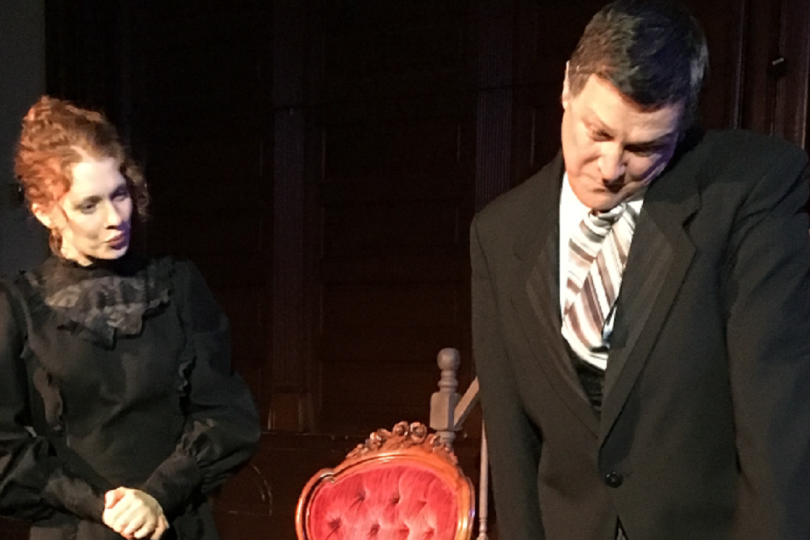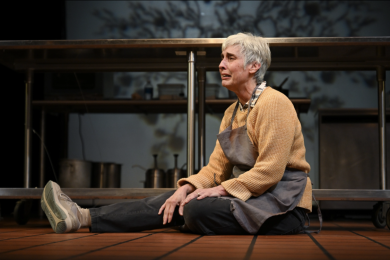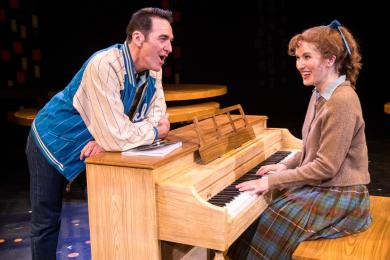The Power of Two

Hero Now Theatre’s new production of The Turn of the Screw comes bundled with a lot of expectations. Not only is it an ambitious reimagining of a literary classic adapted by arguably Minnesota’s most esteemed living playwright, it’s also presented in a nontraditional space that could be described as physically intimidating. Add to that the fact that the program credits a grand total of five people, and you’ve got a production that has a lot to live up to right out of the gate. Fortunately, this Turn of the Screw is up to the challenge.
Hero Now Theatre prides itself on staging shows in unexpected venues that the company classifies as “found spaces.” With the Historic Wesley Center they’ve found one that couldn’t be much better suited to this particular material. The 125-year-old former church in downtown Minneapolis is a picture of stony 19th-Century grandeur on the outside and a cavernous, slightly musty collection of creaking floors and character on the inside. The performance space is a sparse, high-ceilinged room crowned by a frosted glass skylight, its vastness accentuated by the small cluster of audience seating and a set consisting entirely of a chair, a bench, and a short staircase. That interplay of grandeur and austerity gets the play off to an atmospheric start before the actors even take the stage.
When they do, that atmosphere only intensifies, as do the contrasts. Jeffrey Hatcher’s adaptation hews close to the heart of Henry James’s novella, the story of a cheery young governess who stumbles into a nest of grim secrets and barely concealed abuse, but it also takes considerable liberties. The time frame is condensed from a full summer to a single week, and at least two of the principal characters are significantly altered (it’s been a good while since I’ve read the source material, so forgive me if there’s more I’m missing). Most strikingly, the play features six characters but only two actors - the lead role is played by Kayla Dvorak Feld, four supporting roles are played by Edwin Strout, and the remaining role is played by empty space.
It’s that two-person casting that has garnered Hatcher’s adaptation the most publicity in the two decades since its first production. It’s the type of choice that could easily be taken as a grandstanding stunt, or conversely as a pragmatic gesture to budget-minded theater companies, but there’s a definite method to Hatcher’s unorthodoxy. By stripping James’s gothic ghost story down to minimal form, this adaptation is able to focus its attentions all the more tightly on its heroine. While this Turn of the Screw remains a story of doomed lovers, traumatized children, restless ghosts, and a myriad of deviant behaviors, at its heart Hatcher’s play is all about one woman’s agonizing mental collapse.
On paper, Strout would appear to have the more challenging role in this production. Playing the narrator, the master of the house, the housekeeper, and the 10-year-old boy whose disturbing behavior sets the narrative in motion, Strout bounces from charismatic chilliness to dotty domesticity to unsettling precociousness without missing a beat. It’s a role (or collection of roles) that simply wouldn’t work in the hands of a less dexterous performer, and if Strout occasionally threatens to go over the top, it’s always in service of a story that hinges on the unreliability of its narrators. Strout’s characters are all playing roles themselves, whether or not they realize it.
As impressive as Strout is in his multiple parts, though, this show belongs to Kayla Dvorak Feld. Her performance as the governess is an exhilarating thing to witness, building from spirited determination to breathless desperation over the course of 90 expertly paced minutes. While this is not a play of great physicality, director Kristin Halsey creates a propulsive atmosphere around Feld’s monologues and meaningful pauses, taking full advantage of the sprawling yet intimate space and letting the audience marinate in Feld’s warm smiles and haunted stares. Her conversations with Strout’s young schemer crackle with perverse sensuality - the scene in which the two exchange a volley of schoolyard riddles is particularly striking - but her interactions with the girl of the house, a nonverbal child who never physically appears on stage, are somehow nearly as fraught with tension. It’s a remarkable performance that anchors a similarly remarkable production.
I mentioned earlier that the program lists five names, the fifth of those being lighting designer Mark Kieffer. While lighting is an underappreciated and essential element in most plays, it’s rare to see the lighting designer do as much heavy lifting as Kieffer does here. Given the minimal set and close quarters, it falls to the lighting to convey changes in not only mood, but also time, location, character, and stakes. Kieffer’s work here belies the notion that the best technical work is often the least noticeable. The lights in The Turn of the Screw are, well, in the spotlight, and they’re almost as expressive as the actors. If there’s a defining image for this play, it’s Feld staring horrified into the distance as Kieffer’s harsh blue light envelops her in spectral dread.
This is a Turn of the Screw that manages to exceed its lofty expectations on most if not all counts. This isn’t the first time Hatcher’s adaptation has been performed in the Twin Cities and it certainly won’t be the last, but the abundance of talent combined with a singularly ideal venue makes it a production likely to stand with the best of them.




